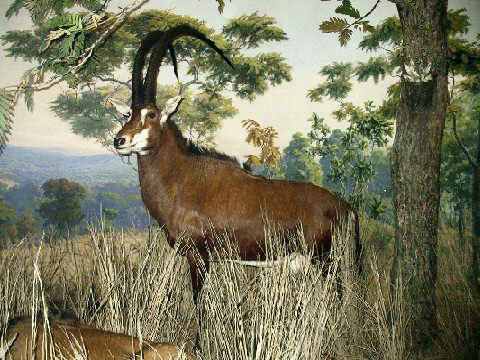|
| 질의: south african museum | 결과: 29번째/31 | |
Giant Sable Antelope (Hippotragus niger variani) - Wiki
| 제목: | Giant Sable Antelope (Hippotragus niger variani) - Wiki
| |

| 해상도: 480x360
파일크기: 56452 Bytes
등록시간: 2007:10:16 22:14:55
|
Giant Sable Antelope
From Wikipedia, the free encyclopedia
[Photo] Giant Sable Antelope (Hippotragus niger variani). Location: American Museum of Natural History, New York - Author: http://commons.wikimedia.org/wiki/User:Stavenn | Permission is granted to copy, distribute and/or modify this document under the terms of the GNU Free Documentation License, Version 1.2 or any later version published by the Free Software Foundation; with no Invariant Sections, no Front-Cover Texts, and no Back-Cover Texts. A copy of the license is included in the section entitled "GNU Free Documentation License". |
The Giant Sable Antelope, Hippotragus niger variani also known in Portuguese as the Palanca Negra is a large, rare subspecies of Sable Antelope native and endemic to the region between Cuango and Luando Rivers in Angola.
They had been thought extinct due to the years of internal civil war within the country until the recent documented sighting of a herd of these large antelopes by Professor Wouter van Hoven of South Africa in 2002.
The Giant Sable Antelope is held in a great deal of respect by the country and people of Angola. This may be the sole reason they survived the long civil war. In African mythology, just like other antelopes, they symbolize the vivacity, the velocity, the beauty and the visual sharpness
The Giant Sable Antelope is evaluated as Critically Endangered on the IUCN Red List of Threatened Species.
Description
Both sexes have horns, which can reach 1,5 meters. Males and females are strikingly similar in appearance until they reach three years of age when the males become darker and develop majestic horns. The male antelope weighs an average of 238 kg with a height of 116-142 cm. Females weigh 220 kg and are slightly shorter than males. The horns are massive and more curved in males reaching lengths of 81-165 cm, while females' horns are only 61-102 cm in length. Coloration in bulls is black while females and young are chestnut, except in southern populations where females turn brown-black. Most sable antelopes have white "eyebrows", a rostrum sectioned into cheek stripes, white belly and rump patch. Young under two months typically are light brown and have slight markings.
Personality
Like all antelopes they are shy by nature, but they can also be very aggressive. The males can be especially dangerous when hurt, attacked, or approached. In the fights, males avoid some serious injuries by kneeling down on their front legs, and engage in horn wrestling fights. Fatalities from these fights are rare.
Habitat
They live in forests near the water, where leaves and tree sprouts are always juicy and abundant. It is an endangered species, so it is protected in natural parks, and hunting it is, therefore, forbidden. Typically, sable antelopes are specialized grazers feeding on foliage and herbs, especially those growing on termite mounds. One of the reasons for the declining in antelope numbers could be their very specific feeding pattern. Typically they will feed on tree leaves, which make up to 90 percent of their diet, at heights of 40-140 mm from the ground, taking only the leaf.
Trivia
* The Angolan National Football Team are fondly known as the Palancas Negras.
http://en.wikipedia.org/wiki/Giant_Sable_Antelope
| The text in this page is based on the copyrighted Wikipedia article shown in above URL. It is used under the GNU Free Documentation License. You may redistribute it, verbatim or modified, providing that you comply with the terms of the GFDL. |
|

|

|

|
south african museum
29/31 |

|
 |
^o^
동물그림창고 똑똑전화 누리집
^o^
|
|